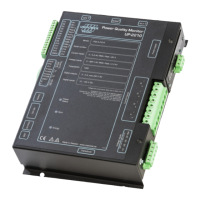Voltage triggers
a) U1-U3 trigs at deviation [% Uref]
A voltage sag (or swell) recording begins when the voltage one of the phases U1-U3 passes the Uref value +/-
the trig level as in Figure 73(1). The recording will have the timing as described above.
The duration of the sag/swell event is calculated to the point where the voltage of all phases U1-U3 is back
within the trig level + the hysteresis value as in Figure 73(2) in accordance to IEC 61000-4-30 Class A.
The purpose of the hysteresis level is to avoid recording secondary events that occur directly following an
important sag/swell. The meter also calculates the depth of the sag/swell as the lowest (sag) or highest (swell)
voltage value during the event. This value is expressed as the residual voltage level in accordance to IEC
61000-4-30 Class A.
If the nominal level in the system is changing, for example in high voltage networks, you can use a sliding
reference nominal level (see Figure 73). The recorder will calculate the average value of the reference
voltage channel (U1) according to the norm IEC 61000-4-30 and create its own reference level. The value of
the sliding reference level will be shown along with each sag/swell.
Normally, if sliding reference is not active, the fixed reference value is used as the nominal voltage.
b) U4 trig level [V]
If the voltage on channel U4 is higher or lower than the reference value +/- the trig level a sag/swell recording
starts.
c) Voltage sum trig level [V]
This trig gives you the possibility to trig on earth faults. Normally the voltage sum U1+U2+U3=0. If this is
not the case you probably have an earth fault and this trigger starts a recording.
Current triggers
a) I1-I3 high trigger
Whenever one of the current phases I1-I3 exceeds the trig level a sag/swell recording starts as described
above. For current you also have the possibility to specify Hysteresis in accordance to the IEC 61000-4-30
norm. In this case the hysteresis is specified as a current value and is added to the trig level. By specifying a
hysteresis level you avoid recording secondary events that occur directly following an important current trig
event.
b) I4 trig level [A]
If the current on I4 exceeds the trig level a sag/swell recording is started.
c) Current sum trig level [A]
This trig gives you the possibility to trig on earth faults. Normally the current sum I1+I2+I3+I4=0. If this is
not the case you probably have an earth fault and this trigger starts a recording.
On high voltage systems you don’t have a neutral conductor and normally don’t use channel I4. In this case,
select 0 as constant on channel I4 (see Figure 8 B) and this trigger will work as intended anyway.
In the interruption tab you can set the level for when a sag/swell becomes an actual interruption. You do this
by setting a percentage value of the nominal voltage value. If the voltage gets under this value the meter will
see this as an interruption. The same hysteresis value is used as in the voltage tab.
According to EN 50160, for instance, the interruption threshold is 1% of the nominal voltage level.
On MV and HV systems there is normally residual voltage at interruptions and the voltage may never go
below 1%. In these cases we recommend a setting of 10% for interruptions.

